Jump Start in PowerShell (Part I)
Only automation. PowerShell only.
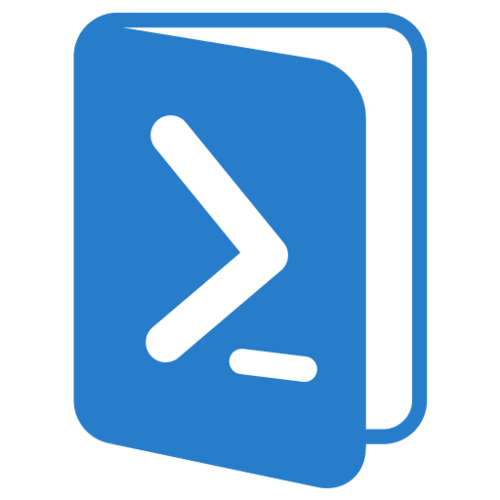
As a hobby and given time, I teach students at UKIT (the former Moscow State College of Information Technology). At the moment I have little time to devote him to a group of students, but it is enough to prepare a post here on Habré.
')
I work as a system administrator in a large non-IT company with a large focus on IT resources. By the nature of the activity, it seems to solve a large number of similar tasks in user services.
I became acquainted with PowerShell about two years ago, but I came to grips with it only a year later, not realizing at first its enormous possibilities. In the article, first of all, I will focus on those who want to start working with PowerShell, but do not trust it yet or don’t know from which side to approach this miracle.
Warning: PowerShell is addictive.
Wikipedia tells us:
PowerShell can look like the command line:
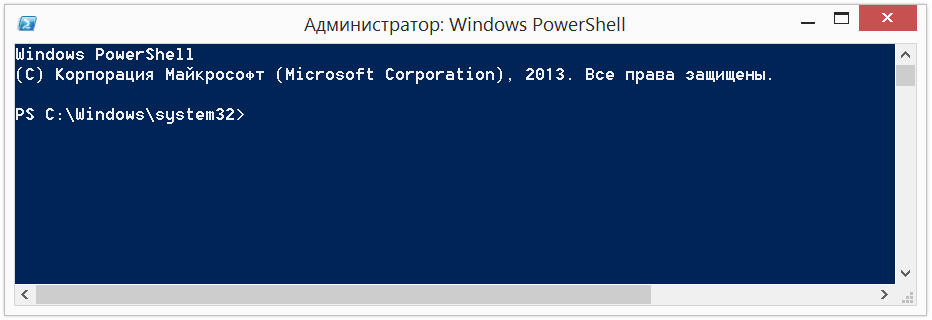
powershell.exe
Or in the form of an application:
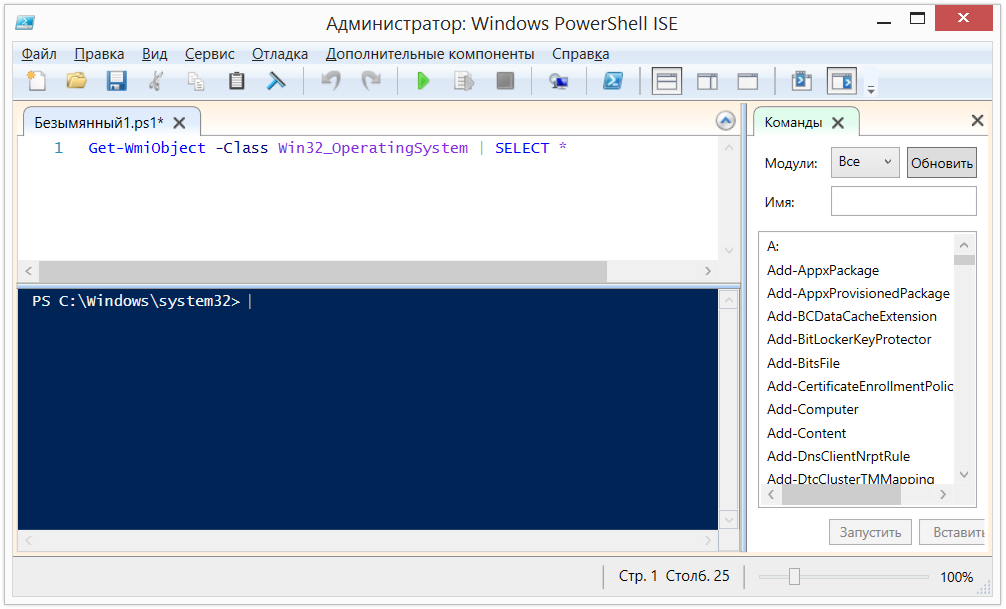
powershell_ise.exe
Powershell_ise.exe is called the integrated script environment - Windows PowerShell ISE. Allows you to work with the language in a convenient environment with syntax highlighting, command constructor, autocomplete commands by pressing TAB and other delights. Ideal for creating and testing scripts.
To launch the powershell.exe or powershell_ise.exe environment, just type the same name in the line to execute.
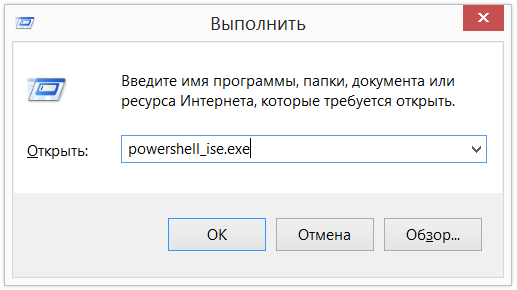
The PowerShell script file has the extension .ps1 .

The script will not work to run a double paint. This is done specifically in order not to harm the system by accidentally running a script.
To start, click on the RMB should choose "Run with PowerShell":
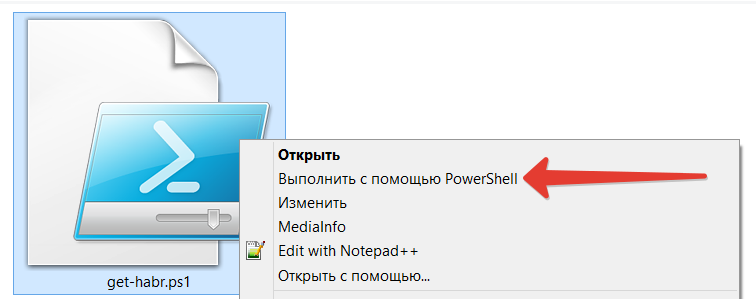
In addition to the fact that there is a restriction on the launch of LKM scripts, by default execution of scripts in the system is prohibited, again, for the reason described above, do not harm the system. To check the current execution policy, run the command:
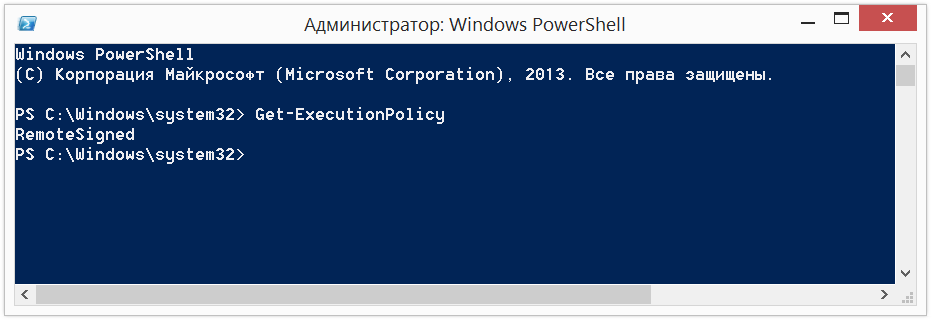
We will get one of the following values. With a high probability, if this was the first launch, we will get Restricted .
For execution and testing, we will lower the policy to RemoteSigned by running the command:
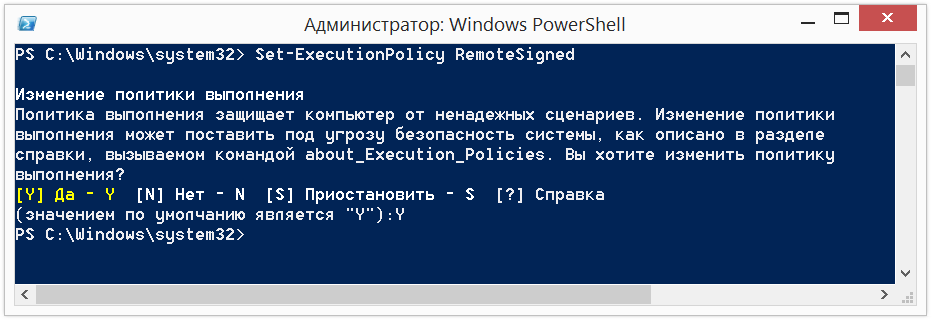
For example, to get the current processes, we run the command:
And we get the result:
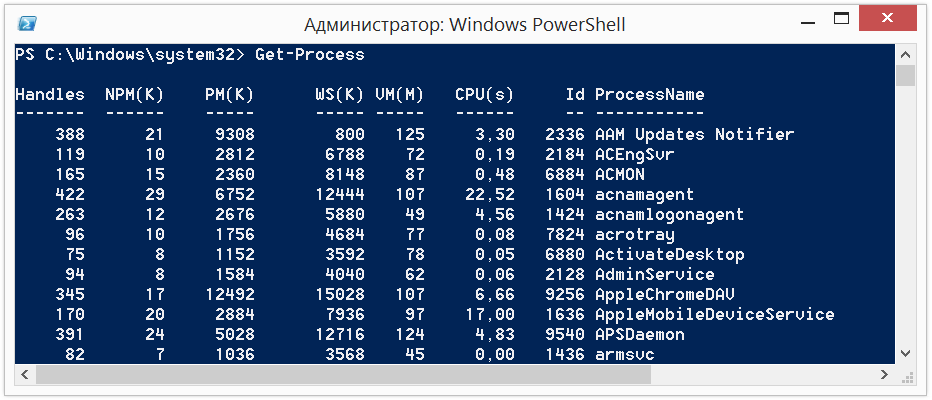
Try it yourself to do:
It’s not necessary to know all the cmdlets by heart. Get-Help will save the situation.
Information on all available cmdlets can be obtained by typing the following command:
If we use PowerShell ISE, we facilitate the development process.
Just enter the dash " - " after typing the cmdlet, and we will get all the possible options for the parameters and their types:

Try this:
If, nevertheless, we forget what properties a particular cmdlet has, run it through Get-Member :
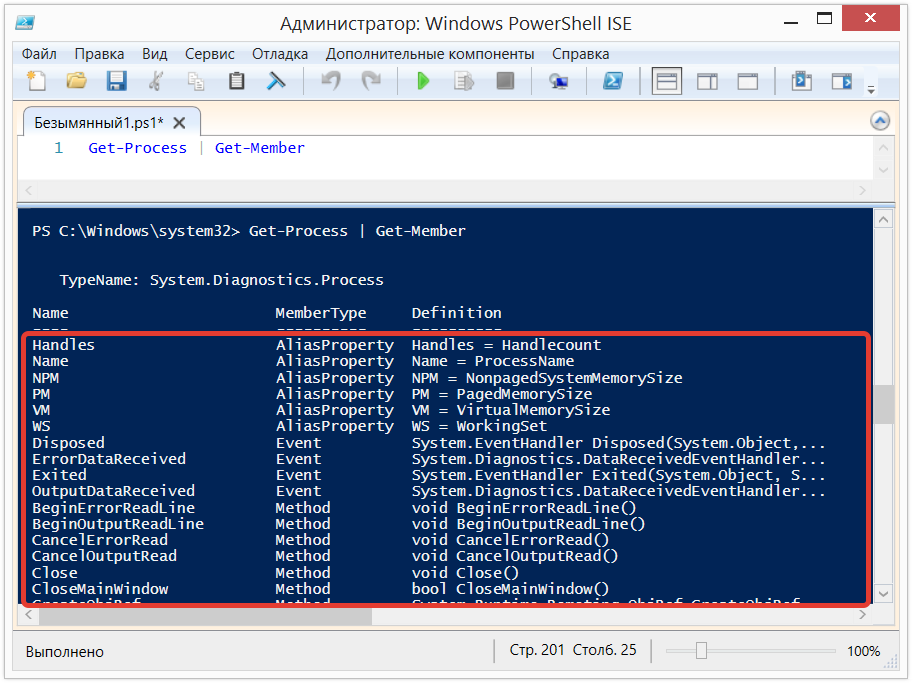
Not enough information? Refer to the help with the -Examples option :
We get a description of Get-Process , and even with examples of use:
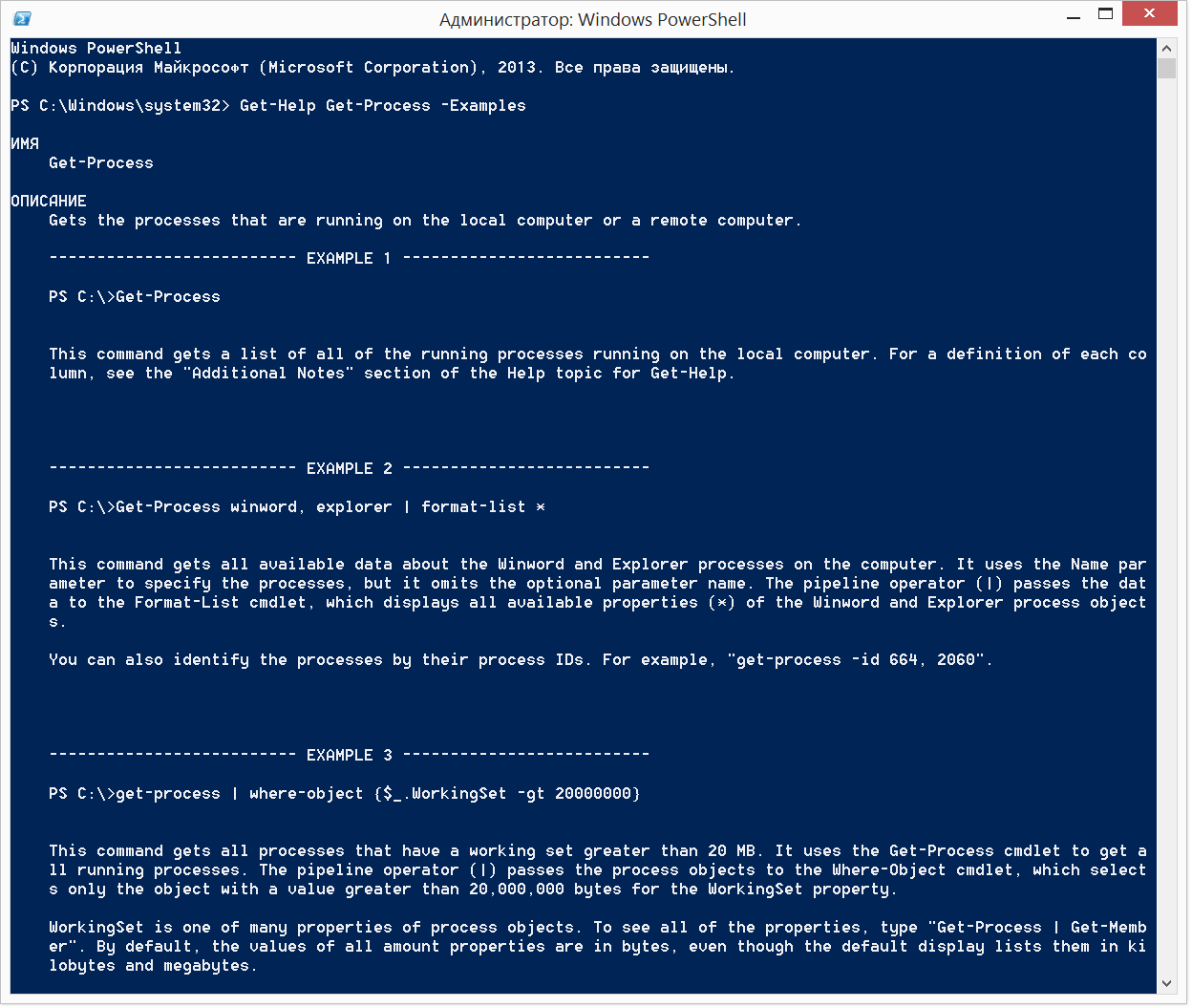
Try this:
What is similar to the recording:
Now stop the process:
Or so:
A little earlier, we said that cmdlets are referred to as Verb-Noun. Clarify that the verb does not have to be Get . In addition to what we can receive, we can set the Set (remember, Set-ExecutionPolicy), start Start , stop Stop , output Out , create New and many others. The name of the cmdlet is not limited to anything, and when we create our own with you, we can name it as it pleases.
Let's try to output to the file:
By the way, you can write the same way:
We all know to use comments is good form.
Comments in PowerShell are lowercase - # and block - <# ... #> :

Let's pay attention to the code from the example:
For those who are familiar with WMI , who do it on good old VBScript, remember how much code you need to write?
Pipeline ( | ) - transmits the output of one command to the input data for processing by another command. We used the pipeline earlier, getting all the properties of the object or, in the previous example, choosing from the data set only the Caption field.
To understand the principle of the pipeline, let's run the code:
What happens: we get all the services (Get-Service), pass all the received services to the sorting cmdlet Sort-Object and indicate that we want to sort them by the Status parameter. At the output, we first get all the services with the status Stop, and then all the services with the status Running.
In the example below, we first get all the services running. After the first pipeline, we go through each element, select only those services for which the status is Running and on the second pipeline we choose what we want to see on the output only the displayname of services:
In the example, we use $ _ . This entry indicates the current item in the pipeline.

In this part, we learned how to run PowerShell, and figured out the script execution policy. Understood what are cmdlets, we know how to pass them through the pipeline and how to get their properties. If we forget something, be sure to get-help.
All this knowledge is necessary to make the first leap into the language. Believe me, many more interesting things!

Foreword
As a hobby and given time, I teach students at UKIT (the former Moscow State College of Information Technology). At the moment I have little time to devote him to a group of students, but it is enough to prepare a post here on Habré.
')
I work as a system administrator in a large non-IT company with a large focus on IT resources. By the nature of the activity, it seems to solve a large number of similar tasks in user services.
I became acquainted with PowerShell about two years ago, but I came to grips with it only a year later, not realizing at first its enormous possibilities. In the article, first of all, I will focus on those who want to start working with PowerShell, but do not trust it yet or don’t know from which side to approach this miracle.
Warning: PowerShell is addictive.
Introduction
Wikipedia tells us:
Windows PowerShell is an extensible automation tool from Microsoft , consisting of a shell with a command line interface and a related scripting language.
PowerShell can look like the command line:

powershell.exe
Or in the form of an application:

powershell_ise.exe
Powershell_ise.exe is called the integrated script environment - Windows PowerShell ISE. Allows you to work with the language in a convenient environment with syntax highlighting, command constructor, autocomplete commands by pressing TAB and other delights. Ideal for creating and testing scripts.
To launch the powershell.exe or powershell_ise.exe environment, just type the same name in the line to execute.

The PowerShell script file has the extension .ps1 .

The script will not work to run a double paint. This is done specifically in order not to harm the system by accidentally running a script.
To start, click on the RMB should choose "Run with PowerShell":

In addition to the fact that there is a restriction on the launch of LKM scripts, by default execution of scripts in the system is prohibited, again, for the reason described above, do not harm the system. To check the current execution policy, run the command:
Get-ExecutionPolicy 
We will get one of the following values. With a high probability, if this was the first launch, we will get Restricted .
- Restricted - Scripts cannot be run;
- AllSigned - Only scripts signed by a trusted publisher can be run. Before executing the trusted publisher script, confirmation will be requested;
- RemoteSigned - Allowed to execute scripts created by us and downloaded scripts signed by a trusted publisher;
- Unrestricted - No restrictions, all scripts can be run.
For execution and testing, we will lower the policy to RemoteSigned by running the command:
Set-ExecutionPolicy RemoteSigned 
Getting Started
Cmdlet
- Cmdlets are PowerShell commands that have different functionality;
- Cmdlets can be either system or user-created;
- The cmdlets are named by the Verb-Noun rule, which makes memorization easier;
- The cmdlets display the results in the form of objects or their collections;
- Cmdlets can both receive data for processing and transmit data through the pipeline (about pipelines later);
- The cmdlets are not case sensitive (you can write get-process, and Get-Process, and GeT-pRoCeSs);
- After the cmdlets do not necessarily put " ; ", except when we run several cmdlets on one line (Get-Process; Get-Services).
For example, to get the current processes, we run the command:
Get-Process And we get the result:

Try it yourself to do:
Get-Service # , Get-Content C:\Windows\System32\drivers\etc\hosts # . , hosts It’s not necessary to know all the cmdlets by heart. Get-Help will save the situation.
Information on all available cmdlets can be obtained by typing the following command:
Get-Help -Category cmdlet If we use PowerShell ISE, we facilitate the development process.
Just enter the dash " - " after typing the cmdlet, and we will get all the possible options for the parameters and their types:

Try this:
Get-Service -Name p* If, nevertheless, we forget what properties a particular cmdlet has, run it through Get-Member :
Get-Process | Get-Member # "|" . . 
Not enough information? Refer to the help with the -Examples option :
Get-Help Get-Process -Examples We get a description of Get-Process , and even with examples of use:

- Cmdlets can have abbreviated names - aliases. For example, instead of Get-Help, you can simply use Help . To get all the abbreviations, do Get-Alias .
Try this:
Start-Process notepad What is similar to the recording:
start notepad Now stop the process:
Stop-Process -Name notepad Or so:
spps -Name notepad A little earlier, we said that cmdlets are referred to as Verb-Noun. Clarify that the verb does not have to be Get . In addition to what we can receive, we can set the Set (remember, Set-ExecutionPolicy), start Start , stop Stop , output Out , create New and many others. The name of the cmdlet is not limited to anything, and when we create our own with you, we can name it as it pleases.
Let's try to output to the file:
"Hello, Habr!" | Out-File C:\test.txt & C:\test.txt By the way, you can write the same way:
"Hello, Habr!" > C:\test.txt & C:\test.txt Comments
We all know to use comments is good form.
Comments in PowerShell are lowercase - # and block - <# ... #> :

Let's pay attention to the code from the example:
Get-WmiObject -Class Win32_OperatingSystem | SELECT Caption For those who are familiar with WMI , who do it on good old VBScript, remember how much code you need to write?
On Error Resume Next strComputer = "." Set objWMIService = GetObject("winmgmts:\\" & strComputer & "\root\cimv2") Set colItems = objWMIService.ExecQuery("Select * from Win32_OperatingSystem",,48) For Each objItem in colItems Wscript.Echo "Caption: " & objItem.Caption Next Conveyor
Pipeline ( | ) - transmits the output of one command to the input data for processing by another command. We used the pipeline earlier, getting all the properties of the object or, in the previous example, choosing from the data set only the Caption field.
To understand the principle of the pipeline, let's run the code:
Get-Service | Sort-Object -property Status What happens: we get all the services (Get-Service), pass all the received services to the sorting cmdlet Sort-Object and indicate that we want to sort them by the Status parameter. At the output, we first get all the services with the status Stop, and then all the services with the status Running.
In the example below, we first get all the services running. After the first pipeline, we go through each element, select only those services for which the status is Running and on the second pipeline we choose what we want to see on the output only the displayname of services:
Get-Service | WHERE {$_.status -eq "Running"} | SELECT displayname In the example, we use $ _ . This entry indicates the current item in the pipeline.

Afterword
In this part, we learned how to run PowerShell, and figured out the script execution policy. Understood what are cmdlets, we know how to pass them through the pipeline and how to get their properties. If we forget something, be sure to get-help.
All this knowledge is necessary to make the first leap into the language. Believe me, many more interesting things!
To be continued...
Additional Information
- Jump Start in PowerShell (Part II) ;
- Download PowerShell v.5 for free without registration ;
- Wonderful course on MVA: Advanced features and scripting in PowerShell 3.0 (Jump Start) . My advice is to look at the first 3 blocks, plunge into the language, try to complete some tasks and see the remaining blocks after a week. Russian subtitles;
- Video on the topic on TechDays;
Technet PowerShell Script Gallery ;
PowerShell Developer Blog .
Source: https://habr.com/ru/post/242425/
All Articles